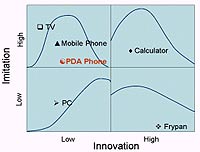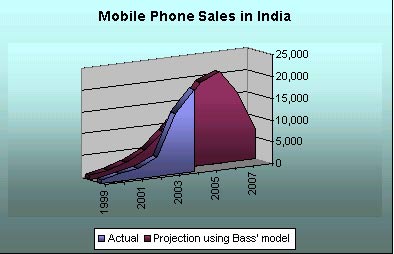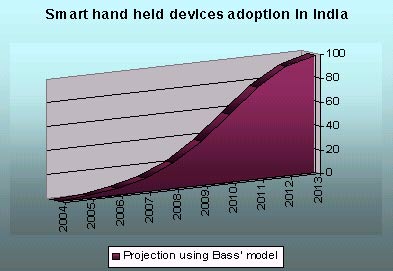PDA phones: The coming revolution
25 May 2005
When computing and communications comprehensively converge in a compact device that fits in your pocket, exciting times are ahead, say Suvarna Singh and Bibhu Choudhary, in their analysis of PDA phones in the Indian market
 It
wasn''t that long ago when a paper notebook, an executive diary and a folder
full of printed documents were the essential contents of the average Indian
executive briefcase. The filofax and the digital diary first made their appearance
in the late ''80s, and replaced both the notebook and the executive diary.
Then came laptop computers, pagers and mobile phones, to keep the executive
connected, equipped and informed while on the move.
It
wasn''t that long ago when a paper notebook, an executive diary and a folder
full of printed documents were the essential contents of the average Indian
executive briefcase. The filofax and the digital diary first made their appearance
in the late ''80s, and replaced both the notebook and the executive diary.
Then came laptop computers, pagers and mobile phones, to keep the executive
connected, equipped and informed while on the move.
Email as the standard of communication comprehensively changed the way the Indian executive worked — but laptops were large, heavy and inconvenient to carry around. So came the personal digital assistant (PDA), a handheld computer which could handle the basic functions of a laptop and could be carried around in a pocket, rather than a bag. The turn of the millennium has brought in the very latest in the computing and communications revolution — the PDA phone.
Though they have been around for over five years, PDA phones first made their appearance in the Indian market in 2004. In the US, Western Europe and Japan, they are considered essential equipment for executives and mobile information workers. The world bought over four million of these devices in 2004 alone. It is only a matter of time before executives in India follow suit.
PDA phones themselves have changed enormously in the five years they have been in existence, in physical appearance as well as the software applications they run. High resolution colour graphics have replaced monochrome screens, battery life has gone up from a few hours to a few weeks, their weight has dropped to just about 100 grams and they can now have up to 128Mb of memory in RAM and ROM.
The pen-like touch screen stylus has revolutionised input technology, support for add-on devices like qwerty keyboards, laser-based keyboards and an external monitor overcomes small screens sizes, making them virtual computers.
On the applications front, we have entire office suites now available on these devices, not to mention seamless messaging, calendar and browsing applications. The mobile phone and the PDA have converged converge into a single handheld computing-cum-communication device.
Adoption of any new technology follows a pattern that is typical of the nature of the technology and that of the consumers. Frank M Bass proposed a model to predict the adoption pattern. This 30-year-old model has seen many extensions by many marketing gurus over the years, but the basic model is still regarded as the gold standard. The prediction is based on three factors - innovation, imitation and total market potential.
Utility items, typically, have a high innovation coefficient. These products get adopted very quickly and reach their peak soon. Those which have a high imitation coefficient, such as status products, take a long time to take off. However, Indian consumers have typically shown higher imitation and lower innovation, as far as their adoption behaviour is concerned.
 ''Figure
A'' explains how television has had an extremely high imitation co-efficient
and low innovation co-efficient. As a result, it got adopted pretty quickly
and reached saturation point very soon. On the contrary, a frying pan does
not have imitation effects, but it does have innovation value. With its introduction
to the market, it was adopted almost immediately, but still hasn''t reached
saturation. The personal computer has taken a comparatively longer time to
take off, but has a relatively smaller maturity period than a frying pan.
''Figure
A'' explains how television has had an extremely high imitation co-efficient
and low innovation co-efficient. As a result, it got adopted pretty quickly
and reached saturation point very soon. On the contrary, a frying pan does
not have imitation effects, but it does have innovation value. With its introduction
to the market, it was adopted almost immediately, but still hasn''t reached
saturation. The personal computer has taken a comparatively longer time to
take off, but has a relatively smaller maturity period than a frying pan.
These coefficients are not a function of the nature of the product alone. They are also tightly bound to the culture and lifestyle of the market. We do not expect the adoption pattern of a microwave oven in India to follow the same trend as in the United States. This is because the two cultures fundamentally differ in lifestyle.
Indian consumers traditionally have been less innovative in trying out new things, but they have shown a greater inclination to imitate the usage of a lifestyle product. PDA phones fall in the category of lifestyle as well as productivity products.
A study on the adoption of mobile phones in recent years indicates that Indian consumers have not been as innovative as their US counterparts (0.001 against 0.008) but they do get as influenced by others'' purchases (0.40 against 0.42). In other words, the Indian market has a relatively low proportion of early adopters.

A glance at the Asia Pacific market gives us an insight into the future of the product in India. Forrester mentions in its report ''Getting to 3 billion mobile users'' that the western markets have reached saturation in the penetration of mobile phones, and the next wave is likely in emerging markets.
Among the emerging markets of the Asia-Pacific region, when we look at reports on the adoption of wireless internet on phones, we find that the entire region follows more or less a similar trend.
| Country | Q1 | Q2 | Q3 | Q4 |
| India | 239.0 | 294.00 | 344.00 | 405.00 |
| Indonesia | 115.0 | 145.00 | 167.50 | 192.00 |
| Malaysia | 569.3 | 717.73 | 877.54 | 1,008.88 |
| New Zealand | 89.0 | 97.00 | 101.30 | 113.00 |
| Philippines | 100.0 | 118.00 | 131.50 | 189.00 |
| Singapore | 283.0 | 598.69 | 729.69 | 860.70 |
| Thailand | 172.0 | 197.00 | 215.75 | 236.00 |
Taking the cultural factors into account when we extrapolate the behaviour of consumers towards a productivity device which has a positive network externality, we predict a low coefficient of innovation and a high coefficient of imitation. Almost half the mobile information workers working for large corporate houses are expected to adopt these smart devices by the year 2010.

The sheer size of the Indian market opens up a plethora of opportunities for manufacturers, distributors, retailers and service providers. General Packet Radio (GPRS) services will be in high demand, as we expect more data-centric devices to take the place of feature phones.
We will see more subsidies being given to the hardware, as service providers try to lower the entry barrier for price-sensitive customers in the country. Hardware manufacturers have already started taking notice of the large numbers predicted and we can see the likes of O2, Motorola, RIM and Dell floating their most popular models here at extremely attractive prices.
All the data surrounding the adoption of similar products in different markets suggests that Indian market is gearing to embrace this new computing paradigm in a big way. Being connected to your corporate network, your emails and all necessary documents will be a common expectation.
While this could
be a boon for the travelling executive, the downside is that you cannot rule
out that your will expect boss that you send him your company report even
when you are on a holiday in Goa!






























